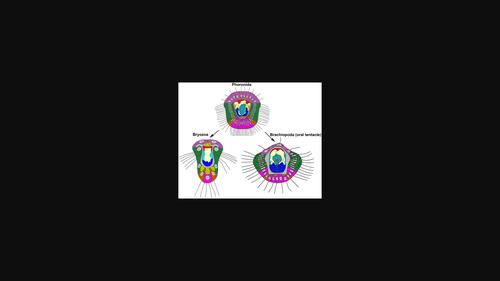当前位置:
X-MOL 学术
›
J. Morphol.
›
论文详情
Our official English website, www.x-mol.net, welcomes your feedback! (Note: you will need to create a separate account there.)
Structure of the oral tentacles of early ontogeny stage in brachiopod Hemithiris psittacea (Rhynchonelliformea, Rhynchonellida)
Journal of Morphology ( IF 1.5 ) Pub Date : 2024-03-16 , DOI: 10.1002/jmor.21686 Tatyana Valerievna Kuzmina 1 , Elena Nikolaevna Temereva 1
Journal of Morphology ( IF 1.5 ) Pub Date : 2024-03-16 , DOI: 10.1002/jmor.21686 Tatyana Valerievna Kuzmina 1 , Elena Nikolaevna Temereva 1
Affiliation

|
Brachiopods have the most complex lophophore in comparison with other lophophorates, i.e., phoronids and bryozoans. However, at early ontogenetic stages, brachiopods have a lophophore of simple morphology, which consists of the oral tentacles. Data on the ultrastructure of the oral tentacles is mostly missing. Nonetheless, it has recently been suggested that the structure of oral tentacles is ancestral for all lophophorates in general, and for brachiopods in particular. The fine structure of the oral tentacles in the brachiopod Hemithiris psittacea is studied using light microscopy, transmission and scanning electron microscopy, cytochemistry and confocal laser scanning microscopy. The oral tentacles have a round shape in transverse section, and four ciliary zones, i.e., one frontal, two lateral, and one abfrontal. Latero‐frontal sensory cells occur among the frontal epithelium. Four basiepithelial nerves in the ciliary epithelium are colocalized with ciliary zones. Lophophores of simple morphology in phoronids and brachiopods are characterized by non‐specified round forms of tentacles. In phoronids and bryozoans, tentacles have additional latero‐frontal ciliary zones that function as a sieve during filtration. In most brachiopods, lateral cilia are involved in the capture of food particles, whereas latero‐frontal cells are retained in the frontal zone as sensory elements. The oral tentacles of H. psittacea contain a coelomic canal and have distinct frontal and abfrontal longitudinal muscles, which are separated from each other by peritoneal cells. A similar structure of tentacle muscles occurs in all bryozoans, whereas in phoronids, the frontal and abfrontal tentacle muscles are not separated by peritoneal cells. We suggest that the lophophorates' ancestor had tentacles, which were similar to the tentacles of some phoronids with lophophore of simple morphology. We also assume that the structure of the oral tentacles is ancestral for all brachiopods and the specialization of brachiopod tentacles correlates with the appearance of the double row of tentacles.
中文翻译:

腕足动物Hemithiris psittacea(Rhynchonelliformea,Rhynchonellida)个体发育早期口腔触手的结构
与其他柄动物(即柄动物和苔藓动物)相比,腕足动物具有最复杂的柄动物。然而,在早期个体发育阶段,腕足动物具有简单形态的触手,由口腔触手组成。关于口腔触手超微结构的数据大多缺失。尽管如此,最近有人提出,口腔触手的结构是所有柄足动物的祖先,特别是腕足动物。腕足动物口腔触手的精细结构鹦鹉螺 使用光学显微镜、透射和扫描电子显微镜、细胞化学和共焦激光扫描显微镜进行研究。口触角横截面呈圆形,有4个纤毛区,即1个前部、2个侧部和1个后部。额外侧感觉细胞出现在额上皮之间。睫状上皮中的四个基底上皮神经与睫状区共定位。拟肢动物和腕足动物的简单形态的触手的特征是非特定的圆形触手。在拟核虫和苔藓虫中,触手具有额外的额外侧纤毛区,在过滤过程中起到筛子的作用。在大多数腕足动物中,外侧纤毛参与食物颗粒的捕获,而外侧额叶细胞则作为感觉元件保留在额叶区。口腔触手鹦鹉螺 包含体腔管并具有明显的额部和前部纵向肌肉,它们通过腹膜细胞彼此分开。所有苔藓动物中都存在类似的触手肌肉结构,而在拟核动物中,额叶和前额触手肌肉不被腹膜细胞分开。我们认为,触手类动物的祖先具有触手,这与一些具有简单形态的触手类动物的触手相似。我们还假设口腔触手的结构是所有腕足动物的祖先,并且腕足动物触手的特化与双排触手的外观相关。
更新日期:2024-03-16
中文翻译:

腕足动物Hemithiris psittacea(Rhynchonelliformea,Rhynchonellida)个体发育早期口腔触手的结构
与其他柄动物(即柄动物和苔藓动物)相比,腕足动物具有最复杂的柄动物。然而,在早期个体发育阶段,腕足动物具有简单形态的触手,由口腔触手组成。关于口腔触手超微结构的数据大多缺失。尽管如此,最近有人提出,口腔触手的结构是所有柄足动物的祖先,特别是腕足动物。腕足动物口腔触手的精细结构



























 京公网安备 11010802027423号
京公网安备 11010802027423号